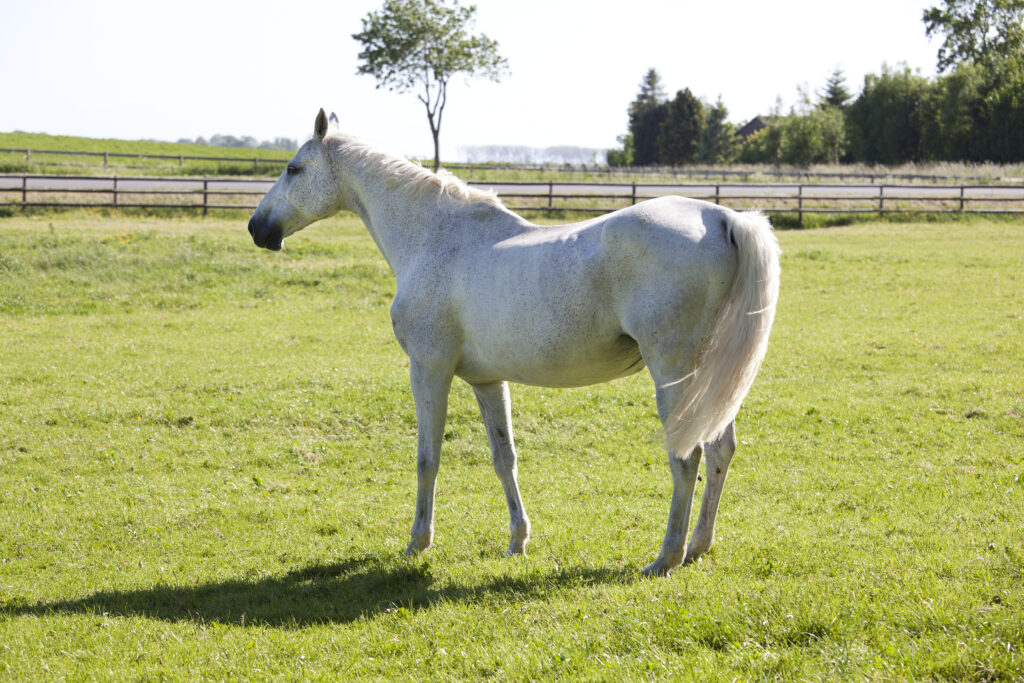
In this episode, Peyton Draheim, DVM, DACT, MS, joined us to discuss uterine biofilms in mares. During the podcast, she explained what a biofilm is and offered strategies for diagnosing and treating them, as well as managing mares with a history of biofilms during breeding season.
What Is a Uterine Biofilm?
Draheim started the conversation by defining uterine biofilms. “A biofilm is basically an aggregate of bacteria as well as an extracellular polymeric substance, or EPS, and this combination is adhered to a surface,” she said.
The bacteria within the biofilm are protected from the host immune system because the body’s white blood cells and antibodies can’t effectively penetrate the thick layer of the EPS. The biofilm also provides a barrier to the diffusion of antibiotics. Bacteria within a biofilm have decreased metabolic and replication rates, making them less susceptible to antibiotics that work best against rapidly multiplying bacteria.
Draheim said veterinarians deal with biofilms regularly. “It’s actually estimated that in nature, about 99% of bacteria can be found to exist within a biofilm matrix,” she said. “These are ubiquitous things that we should expect to encounter, and we’re trying to work on getting some more weapons in our arsenal to combat these biofilms as we encounter them in our mares.”
How Does a Uterine Biofilm Impact Mare Fertility?
Draheim said the most common reason for subfertility in mares is endometritis, usually caused by one of four types of bacteria: Streptococcus equi subs. zooepidemicus, E. coli, Klebsiella pneumoniae, and Pseudomonas aeruginosa. She explained that E. coli, K. pneumoniae, and P. aeruginosa are Gram-negative bacteria—the most likely kind to form biofilms.
“These endometritis cases that are related to a biofilm with those big three Gram-negative bacteria can be resistant to your standard endometritis treatment,” she said. As a result, mares with biofilm endometritis will likely have difficulty conceiving a pregnancy, or they might become pregnant and then lose the pregnancy.
“Having that chronic state of inflammation and infection within the uterus makes it a pretty inhospitable environment for an embryo,” Draheim said.
Signs That a Mare Has a Biofilm
Draheim said she would be suspicious of a uterine biofilm in a mare that has difficulty getting pregnant or a history of repeated pregnancy losses. In addition to history, certain clinical findings make Draheim suspect a biofilm.
“If I do a uterine culture on a mare and she has growth of any of those three Gram-negative organisms I mentioned, and she’s got a history of chronic or recurrent endometritis that just won’t go away, that perks my ears up and makes me suspicious that she’s got a biofilm,” Draheim said.
She advised practitioners to culture dirty mares with a low-volume lavage to sample their uterus, as they could be harboring organisms in areas you can’t reach with a swab. She added that when examining mares via transrectal ultrasound, hyperechoic regions along the endometrial folds can signify a layer of mucus against the endometrium, which can be associated with a biofilm.
How to Treat Uterine Biofilms
Draheim reiterated that bacteria associated with a biofilm are generally going to evade the host’s natural immune system and any treatments administered. She said using pressurized fluid to debride the biofilm off the endometrium also doesn’t work. For those reasons, she said, practitioners must use a biofilm-disrupting agent in addition to an appropriate antimicrobial. Common choices include acetylcysteine, hydrogen peroxide, and Tris-EDTA.
Acetylcysteine is a mucolytic that can both prevent and disrupt biofilms, Draheim explained. “It breaks down those bonds within the mucus layer itself and essentially punches holes in it, melts it away, and exposes those bacteria,” she said. This is a good choice for Pseudomonas endometritis cases.
Draheim usually reaches for hydrogen peroxide for E. coli or K. pneumoniae cases. She said it’s not a good choice for Pseudomonas because the bacteria produce a catalase enzyme that inactivates the hydrogen peroxide.
Tris-EDTA works by disrupting the outer cell wall membranes of Gram-negative bacteria.
Some clinics and laboratories have a biofilm assay that will analyze bacterial isolates for sensitivity to different anti-biofilm agents, which Draheim said can guide your treatment plan.
How to Manage Broodmares With Uterine Biofilms
When managing a mare with a biofilm, Draheim said it’s important to consider why it occurred in the first place: “Is she a mare that looks like she may be battling some sort of endocrine or metabolic disturbance that needs to be addressed to improve her overall fertility and immune function? Does she have a baggy, saggy uterus because she’s an older mare and she has trouble clearing fluid?”
Veterinarians should monitor mares closely before and after breeding for endometrial inflammation or uterine fluid accumulation. They should consider any amount of fluid abnormal in these problem mares, Draheim said. A lavage performed four to six hours post-breeding can help the mare clear fluid. Ecbolic therapy with oxytocin or prostaglandin can also help clear uterine fluid. Exercise, acupuncture, and systemic antimicrobials or anti-inflammatories can be useful. Draheim said these mares can also benefit from probiotic supplementation to help with their overall microbiota equilibrium.
About Dr. Peyton Draheim
Peyton Draheim, DVM, DACT, MS, was born and raised in Charlotte, North Carolina. She earned her Bachelor of Science degree from Clemson University in 2015 and graduated from Lincoln Memorial University’s College of Veterinary Medicine in 2019. She then completed a yearlong internship with Rood and Riddle Equine Hospital in Wellington, Florida, before moving to Alabama to complete her Theriogenology residency with an equine emphasis at Auburn University’s College of Veterinary Medicine. During this time, she participated in multiple research projects involving advanced reproductive techniques in mares, earned her Master of Science degree, and became a diplomate of the American College of Theriogenologists.








